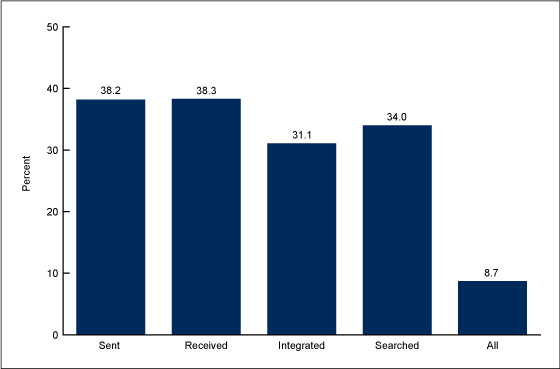 Interoperability of medical records across physician offices remained elusive in 2015, according to the latest data reported out by the Centers for Disease Control (CDC).
Interoperability of medical records across physician offices remained elusive in 2015, according to the latest data reported out by the Centers for Disease Control (CDC).
About 8 in 10 U.S. physicians had an electronic health records system in 2015. One-third of these doctors electronically sent, received, integrated or searched for patient health information — indicating that most physicians still aren’t using EHRs to their fullest extent. These findings come from the NCHS Data Brief from the CDC, State Variation in Electronic Sharing of Information in Physician Offices: United States, 2015.
The bar chart illustrates the percentage of U.S. office-based doctors who sent, received, integrated, or searched for patient health information electronically in 2015. Only 9% of physicians took advantage of all four functions.
Full use of EHRs varies by state:
- The percent of doctors who electronically sent patient health information to other providers ranged from a high of 56.3% in Arizona to a low of 19.4% in Idaho.
- The percent of doctors who electronically received patient health data from other providers ranged from a high of 65.5% in Wisconsin to a low of 23.6% in Louisiana and Mississippi.
- The percent of doctors who electronically integrated patient health information from other providers ranged from a high in 49.3% in Delaware to a low of 18.4% in Alaska.
- The proportion of doctors who electronically searched for patient information from other providers ranged from a high or 61.2% in Oregon to a low of 15.1% in Washington, DC (the District of Columbia).
These data come from the 2015 National Electronic Health Records Survey which polled a national sample of nonfederal office-based patient care physicians between August and December 2015.
Health Populi’s Hot Points: Most U.S. physicians have purchased, installed and are using electronic health records systems, driven primarily by financial incentives they’ve derived from the HITECH Act — part of the Stimulus Bill (more formally, the American Recovery and Reinvestment Act of 2009). Why was this part of the Stimulus package? The policy thinking was that health care costs in America were a key driver of the long-term deficit and so the U.S. health system had invest in the means to measure health spending and outcomes and then manage what we measure.
Without interoperability — that is, the ability to move data where it needs to go throughout the continuum of care and shared across providers who all serve the patient — we can’t fully measure, and thus manage, costs and quality for that N of 1 patient.
U.S. taxpayers have made the investment into EHRs for their doctors. But we’ve still miles to go before we see and benefit from the ROI from fully interoperable digital health records systems. There are promising technologies and standards beginning to be adopted by pioneering informaticists and healthcare systems — FHIR standards for innovating within the EHR environment, and APIs bringing patient-generated data to their personal health records. May 2017 be a new year for health data liquidity and sense-making out of EHRs.




 Interviewed live on BNN Bloomberg (Canada) on the market for GLP-1 drugs for weight loss and their impact on both the health care system and consumer goods and services -- notably, food, nutrition, retail health, gyms, and other sectors.
Interviewed live on BNN Bloomberg (Canada) on the market for GLP-1 drugs for weight loss and their impact on both the health care system and consumer goods and services -- notably, food, nutrition, retail health, gyms, and other sectors. Thank you, Feedspot, for
Thank you, Feedspot, for  As you may know, I have been splitting work- and living-time between the U.S. and the E.U., most recently living in and working from Brussels. In the month of September 2024, I'll be splitting time between London and other parts of the U.K., and Italy where I'll be working with clients on consumer health, self-care and home care focused on food-as-medicine, digital health, business and scenario planning for the future...
As you may know, I have been splitting work- and living-time between the U.S. and the E.U., most recently living in and working from Brussels. In the month of September 2024, I'll be splitting time between London and other parts of the U.K., and Italy where I'll be working with clients on consumer health, self-care and home care focused on food-as-medicine, digital health, business and scenario planning for the future...